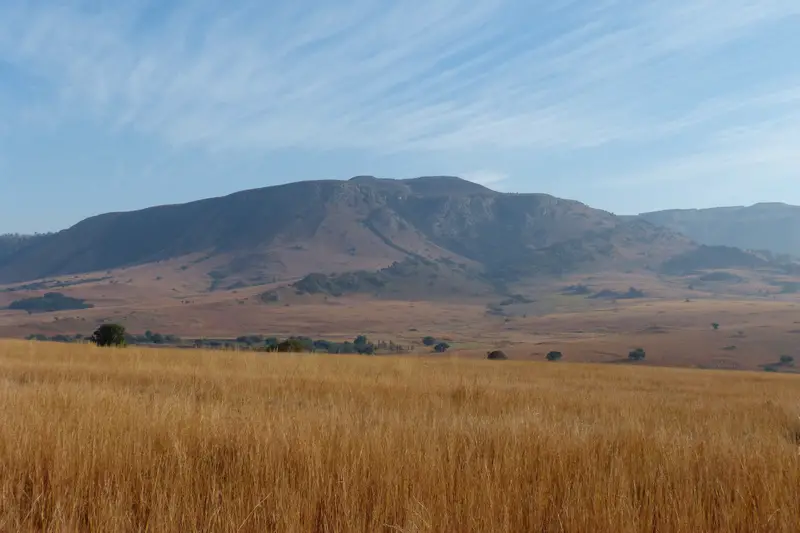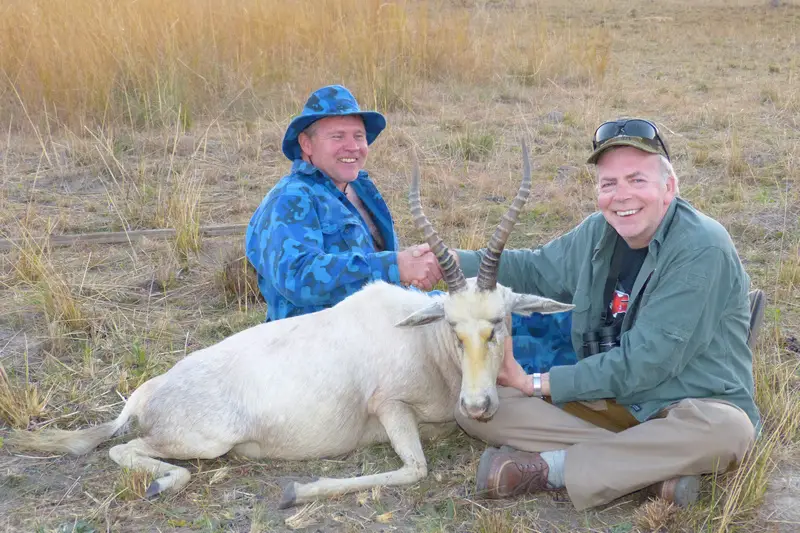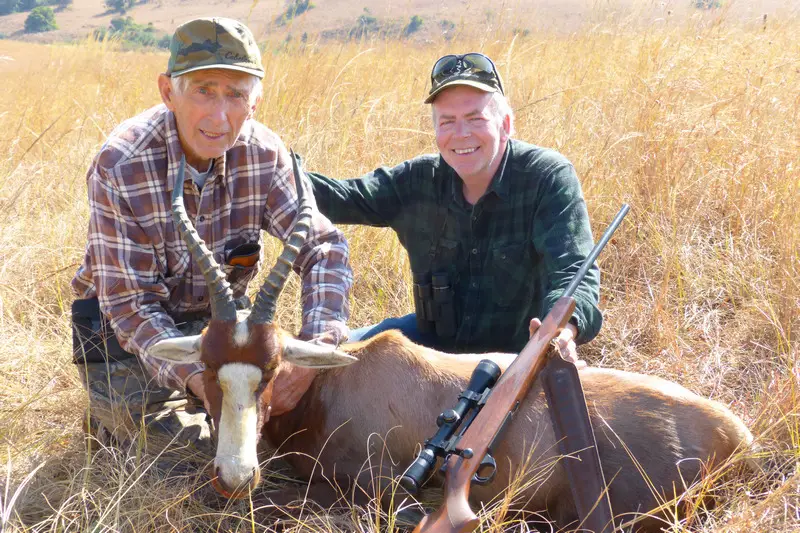


Hunting in South Africa Part One: Blesbok
The Blesbok is one of several medium native South African antelope, getting up to 85 kg or so (187 pounds). The name refers to the Dutch term for blaze, while others feel the “bles” means bald, the white patch of the common Blesbok yielding a bald appearance. Bok itself comes from the Dutch, meaning antelope or goat, so you have “blaze antelope” or “bald antelope” as a result.
Blesbok are grazers as opposed to browsers or leaf-eaters, preferring the short grass. They are herd animals, and can be quite difficult to stalk. They certainly were for Karel Haefele of Ke Monati Safaris and myself, for we were busted again and again during many miles of approaches. Even using the bushes, dips in the terrain, and so forth they often hit the road before we could get within five of six hundred yards. There are hundreds of sets of eyes, including impala in the same area, so when one animal decides to spook, often they all go.
You might have heard the term “plains game” used, although there really is no such thing. It is a confusing term sometimes uses to describe animals other than the Big Five or something rare or exotic. The last time we hunted South Africa we were in Bushveld. The three broad categories of South African hunting terrain are Bushveld, Middleveld, and Highveld. Veld, loosely translated, means field. This time, we hunted Middleveld which included both tall and short grass, mountains, streams, ponds, rocks, and some trees and bushes. The second area we hunted was all Highveld, almost exclusively tall grass in flat fields without much other cover other than dips and rises in what is primarily wide open grassland.
The first evening, after confirming our rifles, we hit the Middlevelt and although we saw thousands of animals, we didn't get into the 350 yard area except for a very late sunset stalk. July is winter in South Africa, although it wouldn't meet the North American view of cold weather at all. At night, temperatures got into the low thirty degree F. range, approaching the freezing point, but the days were in the middle 70s to lower 80s, gorgeous and sunny.
The second day, after countless attempted approaches, we did get within 325 yards of a large group of common Blesbok with a couple of very nice rams. Although both male and female Blesbok have horns, the male horns have far more mass, though at 600 yards most would be hard pressed to be able to tell. Even at closer ranges, it is more of a nuanced difference and it takes a while to be able to quickly pick up on the differences.
Anyway, the sticks went up, the X-Bolt was on the best ram, the safety was off, the finger was on the trigger. The Blesbok were starting to spook, thanks to an impala herd, the wind had picked up, so with a raking shot at a moving animal with a crosswind right at 340 yards, it was decision time. I decided not to hit the switch, though that Blesbok ram will never know how very close it was. We skipped our planned brunch and just kept on hunting.
Late in the day, we had spotted a smaller group of Blesbok with two white Blesbok rams, one of which looked to be quite good, at least from a distance. Karel and I were able to get into good position, so we could do our stalk through the tall grass with the wind in our faces, moving downhill. Karel spotted the ram first, just small patch of white from his back through the tan grass. I couldn't see him at first, I was looking farther out, but finally picked up the white patch.
We moved a bit closer and the sticks went up in the wind. We were almost sure it was the one, but we weren't completely sure. So, we had to wait to see if he would pick up his head for a final look. He did, his head just above the tall grass though he was working through the short pasture area with new growth. Once re-verified, that was it and a shot rang out a fraction of a second later.
Some animals shrink when they hit the ground, a lesser number tend to grow. This white Blesbok grew, quite a bit actually, for the horns were 16-1/2 inches or so, substantially better than we thought. The Rowland Ward record book minimum is 16-1/2 inches for a Blesbok, so this one is going to be extremely close. You can check the various qualifying sizes and records at http://www.rowlandward.com .
The white Blesbok ram took zero steps and the 130 grain Hornady Interbond created a huge wound channel, the lungs turned instantly into gel. It was very good expansion on what is just a medium sized African antelope. A Blesbok is perhaps half again the size of a Springbok, maybe marginally heavier than an impala, but nowhere near the size of a red Hartebeest which can hit the 330 pound arena. In any case, this Blesbok is making a beautiful trophy, and was a satisfying start to this year's hunt.
As you might imagine, opinions vary all over the place as to what game tastes the best. Karel feels Blesbok makes some of the finest biltong. Many feel that both Springbok and Eland offer the best steaks; we had both Kudu and some fresh red Hartebeest while we were there and found them both to be delicious. Like many things, it has a lot to do with how the meat is handled and prepared as much as anything else.
Nothing goes to waste on a South African game animal. You see this again and again: if not for hunters, there would be preservation and restoration of natural habitat and no one cares more about healthy game populations than the hunter. Hunters take old animals, almost exclusively old males, a far better thing than what nature has planned for the old ram or bull: Animals like this, after wearing out their teeth, tend to starve and weaken until the jackals can start to chew on them alive. It is a far more respectable end to a beautiful animal, to live a long and healthy life, ended in a split second, and completely enjoyed and revered rather than the harsh, grueling end that nature has in store for them. I'm quite proud to be a hunter: everyone should be.
The next day, my favorite hunting buddy (disguised as my eight-five years old father) got his chance at a nice Blesbok. A large herd was spotted, and we set up across a rocky stream behind a stand of trees. We had a volunteer to move them, not an arduous task as the Blesbok had been very, very wary. We hoped that part or all of them might head to the popular pasture grazing area that we were near, but of course they could go most anywhere they wanted. Sometimes, it is far better to be lucky than good. I'll take the lucky most every time.
Though as far from a certainty as there can be, the Blesbok cooperated in part, while not moving to the area where we thought, they moved within range and there was an excellent ram in the group. Dad did the rest with a single shot from his Weatherby Vanguard Series 2 Sporter.
If there is a best choice for South Africa hunting, there is no better way to enjoy it than with Karel Haefele. Check out Ke Monati Safaris at http://kemonatisafaris.co.za/ to plan your next hunting adventure with Karel.
© Copyright 2003-2013 by Randy Wakeman. All Rights Reserved.





